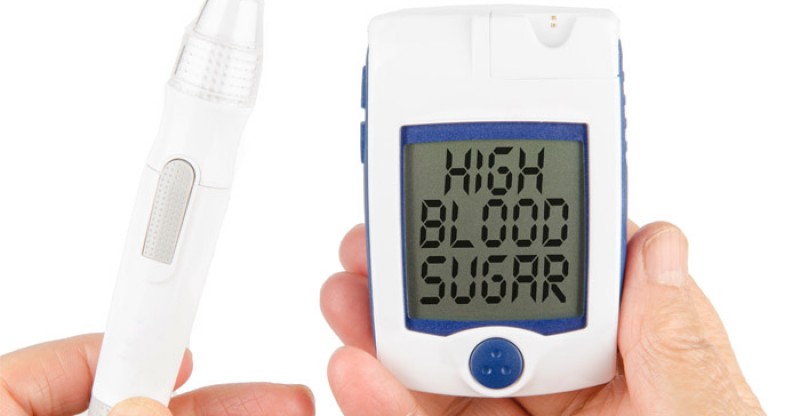How to Lower Blood Sugar Naturally (16 Science-Backed Ways)
High blood sugar (also known as hyperglycemia) happens when there’s an excess of glucose circulating in the bloodstream.
Most of us experience hyperglycemia throughout the day, as blood-sugar levels naturally fluctuate.
They rise after we eat meals, then drop back down as our bodies absorb the glucose.
However, if these levels fail to drop, it can lead to serious health complications down the line.
Stroke, organ failure, and diabetes can all arise as a result of chronic high blood sugar.
The good news is that you can easily manage your blood sugar levels at home.
With just a few simple changes to your diet and lifestyle, you can naturally lower your blood sugar, and keep it low!
So here are our top 16 ways to naturally reduce your blood sugar levels, so you can be healthier and happier.
Hydrate
Adequate hydration is such a simple way to stay healthy, yet so many of us have trouble drinking enough water.
However, hydration absolutely essential if you’re suffering from high blood sugar.
Drinking enough water plays a key role in weight management, and it can significantly increase weight loss and lower blood glucose levels (2).
Drinking water causes our bodies to burn fat quicker, which stimulates our bodies to remove more glucose from our blood (3).
Remember: You should be aiming to drink around two liters of plain water per day. Avoid sugary beverages like soda and fruit juice. They’ll only raise your blood glucose levels more.
Relax
We all experience stress in our day-to-day lives, but you may be surprised to learn that it can play a significant role in increasing your blood sugar levels (4).
When we’re stressed, our bodies release a whole host of stress hormones.
Some of them (especially glucagon) can cause our blood sugar levels to rise (5).
There are several ways you can minimize stress, and two of the best are meditation and yoga.
In particular, yogic exercise has been scientifically proven to lower stress and blood glucose levels (6).
Remember: Find ways to reduce stress in your life, and consider practicing yoga or meditation as a means of reducing stress levels. It’ll benefit your blood sugar and your general mood.
Exercise
Regular exercise is one of the most important factors for maintaining a healthy lifestyle and safeguarding your physical and mental well-being.
Therefore, it should come as no surprise that it can also be beneficial for reducing blood sugar levels.
Exercise immediately decreases blood glucose levels, and these lower levels can be sustained for up to three hours afterward (7).
When we exercise, our bodies require more energy, so they’ll absorb more sugar from the blood to use as fuel.
Remember: Regular exercise can help us maintain a healthy weight and significantly reduce blood sugar levels.
Pay Attention to Carbs
Foods rich in carbohydrates can seriously hinder your efforts and keep your blood sugar levels low.
The body breaks carbs down into glucose, which is the main culprit when it comes to hyperglycemia.
The science behind this root cause is strong.
A wide range of studies concludes that a low-carb diet reduces blood sugar levels, and it can keep them low in the long term (8, 9).
Remember: Limit your intake of refined carbohydrates to help keep your blood sugar levels low (including white bread, white potatoes, white pasta, and white rice).
Focus on Low GI Foods
Low GI foods score low on the Glycemic Index, which is a measure of the body’s blood sugar response after eating food containing carbs (10).
Incorporating more Low GI foods into your diet (in place of refined carbohydrates) is a great way of lowering your blood glucose levels and keeping your weight down (11).
Remember: To lower your blood sugar levels, eat more Low GI foods (such as sweet potatoes, wholegrain pasta, bread, rice, beans, and oats).
Eat Plenty of Fiber
There are many health benefits of eating a high-fiber diet.
The recommended daily intake is 25g for women and 38g for men (12).
However, most people don’t eat nearly enough, which is bad news for our bodies (especially if you suffer from high blood sugar levels).
Eating a high-fiber diet has been scientifically proven to significantly reduce hyperglycemia (13, 14).
Remember: To keep your blood sugar levels low, pack your diet with high-fiber foods (such as fruits, vegetables, whole grains, and legumes).
Garlic
Garlic is both delicious and medicinal.
It’s been found to have many wonderful health properties.
Considered by many to be a superfood, garlic can boost metabolism, prevent cardiovascular disease, treat infection, and even reduce the risk of cancer (15).
And garlic can even lower blood sugar levels by increasing the secretion of insulin and the body’s sensitivity to insulin (16).
As insulin is the chemical responsible for transporting glucose into the cells, garlic significantly reduces the amount in the blood.
Remember: Eating more garlic can lower your blood sugar levels and protect you from a wide range of other diseases.
Ginger
Just like garlic, ginger is considered to be a superfood.
Used for thousands of years to treat colds, headaches, nausea, and arthritis (17), it’s also significantly effective at lowering blood glucose levels (18).
Ginger enhances insulin sensitivity, which increases the uptake of glucose from the blood (19).
Remember: A good way to up your ginger intake is a natural ginger tea. Pour boiling water over raw, sliced ginger root, add a little honey, and enjoy.
Cinnamon
The fact that cinnamon lowers blood sugar has been well-established, and it has a wealth of scientific evidence to back it up (20, 21, 22).
Just like garlic and ginger, cinnamon increases insulin sensitivity.
Therefore, it reduces blood sugar levels by removing more of it from the blood (23).
Remember: Up your cinnamon intake, but don’t overdo it. Any more than 6g per day can be harmful (24).
Sleep Tight
Getting a decent night’s sleep is instrumental in keeping us alert and functional.
But surprisingly, it can also influence our blood sugar levels.
Studies have found that sleep deprivation results in increased blood sugar levels the following day, possibly due to a decrease in the action of insulin (25).
Over time, losing out on your beauty sleep can increase the risk of obesity and diabetes (26).
So there’s a lot to be gained from getting to bed early.
But beware: regularly snoozing for more than 9 hours each night can also up your chances of developing diabetes (27).
Remember: To keep your blood sugar levels (and risk of diabetes) low, aim to get 7-8 hours of good quality sleep every night.
Stay Slender
Regular exercise, a healthy diet, and portion control are vital for keeping the extra pounds off and staying slim.
Maintaining a healthy weight is crucial for keeping your blood sugar levels low and reducing your risk of developing diabetes in the long term (28, 29).
Studies have found that waist measurements are linked with an increased risk of developing diabetes.
So women should try to stay under 35 inches, and men under 40 inches (30).
If your waistline exceeds these measurements, you’re at greater risk of developing insulin resistance and high blood sugar (both of which can lead to the development of type 2 diabetes).
Remember: When it comes to reducing your blood sugar levels, dropping a few extra pounds can make all the difference.
Apple Cider Vinegar
Also, consider adding apple cider vinegar to your diet.
Vinegar has been found to have several health benefits, and it’s been used to treat infection, lower blood pressure, prevent cancer, and lower blood sugar levels (31).
Apple cider vinegar is another one of those foods that increase insulin sensitivity, facilitate the removal of glucose from the blood, and help maintain a healthy blood sugar level (32).
Remember: Try to incorporate more apple cider vinegar into your diet — by adding it to salad dressings, or mixing a few teaspoons into a glass of water.
Fenugreek Seeds
Fenugreek is a medicinal herb that’s been around for a long, long time.
When you see its remarkable list of health benefits, it’s easy to see why.
It can be used to treat fever, reduce body pain, and alleviate the swelling.
It can also protect against cancer, malaria, allergies, and infection.
And it can lower cholesterol, reduce body fat, and control diabetes (33).
And like all the other wonderful plants on this list, it can reduce blood sugar levels.
Studies have also found that fenugreek seeds can significantly lower levels of glucose in the blood (34), which can reduce the risk of developing diabetes.
Remember: Fenugreek seeds can be found at health food stores, and they’re definitely a method worth trying to keep your blood sugar levels low. Try grinding them into a powder and using it as a yogurt topper.
Berberine
Berberine is a powerful plant extract that’s been used as a treatment for diabetes in traditional Chinese medicine for thousands of years.
It’s one of the most effective herbal remedies, and it’s been found to significantly reduce blood sugar levels (35).
Berberine works by increasing insulin sensitivity and enhancing the uptake of glucose from the blood, which causes blood sugar levels to naturally drop (36).
It’s also been found to increase the metabolism of glucose and fats (37), so it can also be useful for keeping the weight off.
Remember: Berberine pills can be picked up at most health food shops, and it’s a great addition to the diet of anyone trying to lower their blood sugar.
Magnesium and Chromium
You may not be getting enough magnesium and chromium.
Both of these micronutrients are beneficial for keeping high blood sugar levels at bay.
Magnesium works to lower blood sugar by mobilizing glucose in the bloodstream.
So it makes it easier for your body to absorb it and turn it into fuel for the muscles (which is particularly useful when exercising) (38).
Some evidence suggests that chromium is also useful for increasing insulin sensitivity. Therefore, it could decrease blood sugar levels (39).
Remember: Add more foods that are rich in magnesium and chromium. They’ll keep your blood sugar levels down.
To boost your magnesium intake, go for dark, leafy greens, fish, beans, nuts, and yogurt. For chromium, eat egg yolks, sweet potatoes, oats, and whole grains.
Monitor Your Blood Sugar Levels
If you have trouble keeping your blood sugar levels down, it’s important to monitor them regularly.
That way, you can keep an eye on things, so you’ll know when to take action.
Keeping tabs on your blood glucose levels can help you decide whether you need to change your diet or exercise regime.
And it can help you figure out how your body reacts to certain foods (40).
Remember: You can pick up a very inexpensive blood glucose monitor online. It should track your blood sugar levels throughout the day.
If you keep a diary of your blood sugar levels, it can help you stay on top of your diet and lifestyle.
Conclusion
If you have problems with your blood sugar levels, these tips can help you keep the glucose levels in your blood to a minimum and prevent you from developing diabetes down the line.
If you’re already diabetic, take steps to control your blood sugar levels.
They can help keep you stay healthy, and reduce the risk of developing nasty complications.
Always seek the advice of your doctor before undergoing any major lifestyle changes.
And remember – it’s easy to stay healthy when you know how to.
FDA Compliance
The information on this website has not been evaluated by the Food & Drug Administration or any other medical body. We do not aim to diagnose, treat, cure or prevent any illness or disease. Information is shared for educational purposes only. You must consult your doctor before acting on any content on this website, especially if you are pregnant, nursing, taking medication, or have a medical condition.
HOW WOULD YOU RATE THIS ARTICLE?







I can’t make myself drink 2 liters of water…Can I add any healthy ingredient to it to add some flavor?
Will cinnamon work if I add it to my morning coffee?